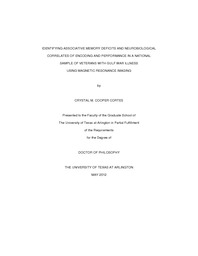
ATTENTION: The works hosted here are being migrated to a new repository that will consolidate resources, improve discoverability, and better show UTA's research impact on the global community. We will update authors as the migration progresses. Please see MavMatrix for more information.
Show simple item record
| dc.contributor.author | Cooper Cortes, Crystal Marie | en_US |
| dc.date.accessioned | 2012-07-25T19:10:18Z | |
| dc.date.available | 2012-07-25T19:10:18Z | |
| dc.date.issued | 2012-07-25 | |
| dc.date.submitted | January 2012 | en_US |
| dc.identifier.other | DISS-11738 | en_US |
| dc.identifier.uri | http://hdl.handle.net/10106/11119 | |
| dc.description.abstract | Roughly 26-32% of U.S. veterans who served in the Persian Gulf War of 1991 report suffering from chronic health problems (Golomb, 2008). Memory complaints are regularly reported by ill Gulf War veterans (GWV), but there is scarce data to verify their complaints. Using an associative memory paradigm of faces and names, the present study was conducted to investigate the memory deficits reported by ill GWV in a nationally representative sample comprised of both ill and well GWV. During administration of the memory task, functional magnetic resonance imaging (fMRI) was used to acquire the Blood Oxygenation Level Dependent (BOLD) contrast to serve as a proxy of brain activation evoked by the memory task. Additionally, measures of N-acetylaspartate (NAA) and creatine (Cr) were obtained from the left and right hippocampus of participating veterans using single voxel magnetic resonance spectroscopy (MRS). The ratio of NAA to Cr obtained from MRS serves as a proxy for functional neuronal mass in the hippocampus during a resting state. It was hypothesized that affected GWV would demonstrate decreased memory performance relative to unaffected GWV on the associative memory test, providing evidence of memory deficits using an objective measure of memory. This was confirmed. In addition, I hypothesized that these memory differences would be related to differences in brain function during the encoding of novel associative memories. Specifically, I predicted that differences would be observed between the ill and well GWV in the amount of brain activation measured during associative memory encoding using BOLD fMRI. Such differences were observed in several brain regions. However, hippocampal differences did not follow predictions. Lastly, I predict that the NAA/Cr ratio level measured in the hippocampus will differ between ill and well GWV. Moreover, I predict that the NAA/Cr ratio measured in the hippocampus will be correlated with performance on the associative memory test. Group differences were observed. However, NAA/Cr concentrations were not consistently correlated to associative memory performance. | en_US |
| dc.description.sponsorship | Odegard, Timothy | en_US |
| dc.language.iso | en | en_US |
| dc.publisher | Psychology | en_US |
| dc.title | Identifying Associative Memory Deficits And Neurobiological Correlates Of Encoding And Performance In A National Sample Of Veterans With Gulf War Illness Using Magnetic Resonance Imaging | en_US |
| dc.type | Ph.D. | en_US |
| dc.contributor.committeeChair | Odegard, Timothy | en_US |
| dc.degree.department | Psychology | en_US |
| dc.degree.discipline | Psychology | en_US |
| dc.degree.grantor | University of Texas at Arlington | en_US |
| dc.degree.level | doctoral | en_US |
| dc.degree.name | Ph.D. | en_US |
Files in this item
- Name:
- Cortes_uta_2502D_11738.pdf
- Size:
- 1.573Mb
- Format:
- PDF
This item appears in the following Collection(s)
Show simple item record


